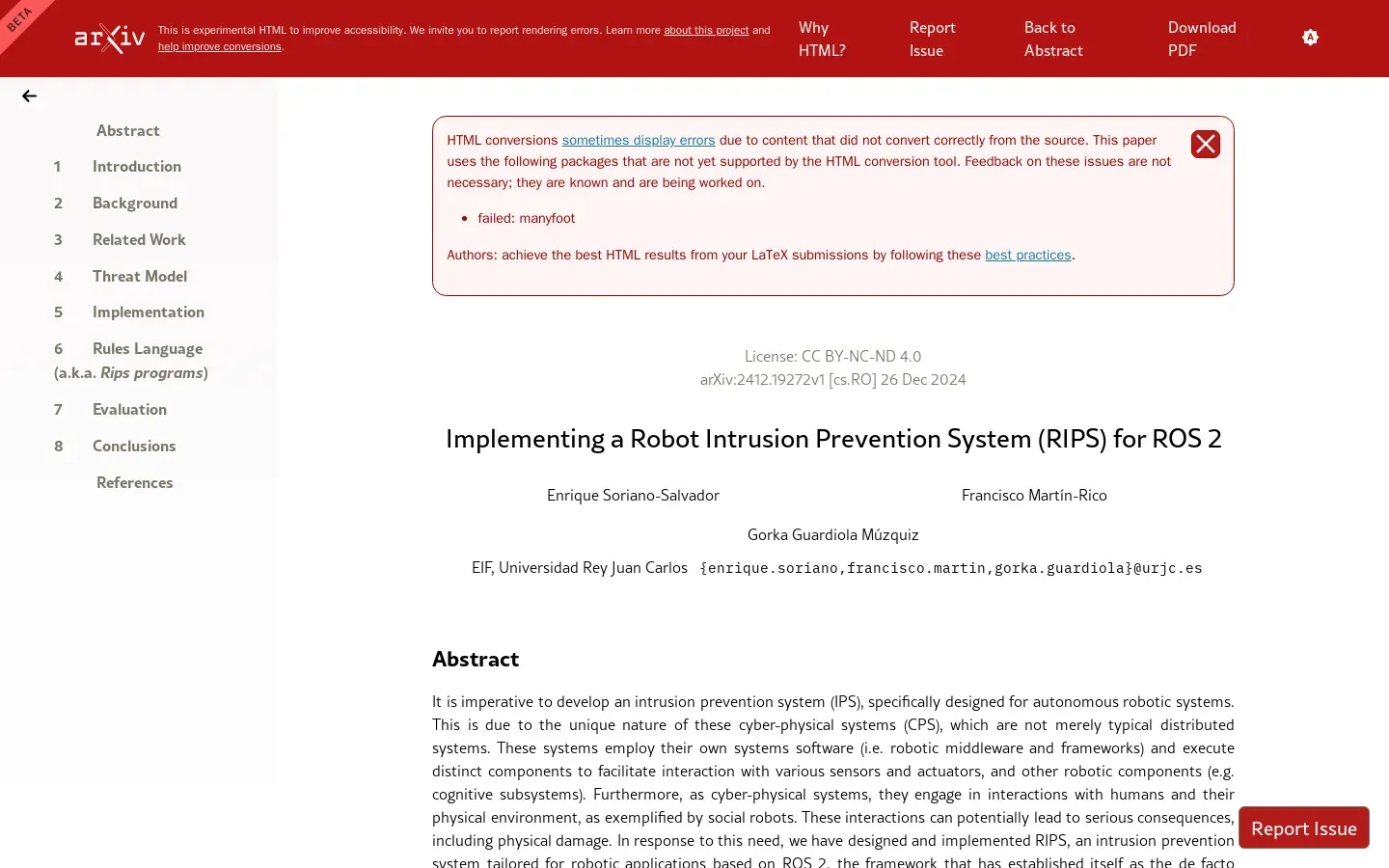
Robotic Intrusion Prevention System Developed for Cybersecurity
/ 4 min read
Quick take - Recent research has introduced the Robotic Intrusion Prevention System (RIPS), a new framework designed to enhance cybersecurity for autonomous robotic systems through real-time monitoring, customizable security policies, and dynamic threat response mechanisms.
Fast Facts
- Introduction of RIPS: The Robotic Intrusion Prevention System (RIPS) is designed to enhance cybersecurity for autonomous robotic systems amid increasing robot deployment across various sectors.
- Key Features: RIPS includes a robust architecture for real-time monitoring, a custom domain-specific language for tailored security policies, and integrated safety mechanisms for effective threat response.
- Significant Findings: The system shows improved intrusion detection, dynamic threat response, customizable security protocols, and maintains performance without compromising robotic functionality.
- Strengths and Limitations: RIPS offers innovative security approaches but requires further research on cross-domain applications and resilience against physical attacks.
- Future Applications: RIPS has potential applications in smart cities, healthcare robotics, collaborative manufacturing, and the development of advanced threat detection algorithms.
Advancements in Robotic Cybersecurity: The Development of the Robotic Intrusion Prevention System (RIPS)
In an era where autonomous robotic systems are becoming integral to various sectors, the need for robust cybersecurity measures has never been more critical. Recent research has introduced the Robotic Intrusion Prevention System (RIPS), a pioneering initiative designed to fortify these systems against potential cyber threats. As robots become more prevalent in industries ranging from healthcare to manufacturing, ensuring their security is paramount.
The RIPS Framework: A New Era in Robotics Security
The primary objective of the RIPS project is to create a comprehensive security architecture specifically tailored for autonomous robots. At its core, RIPS is designed to monitor and respond to security breaches in real-time, offering a dynamic defense mechanism against unauthorized access attempts.
Key Components of RIPS
-
Architecture Development: The foundational structure of RIPS focuses on real-time monitoring and response capabilities, enabling it to detect and mitigate threats as they occur.
-
Custom Domain-Specific Language (DSL): This specialized language allows for the definition of security rules and policies that are context-specific, providing tailored protection based on operational needs.
-
Real-World Testing: Rigorous evaluations in practical scenarios have been conducted to assess the system’s effectiveness, ensuring that it performs well under real-world conditions.
-
Safety Mechanisms Integration: Protocols are embedded within RIPS to ensure that robotic systems can safely respond during threat detection, minimizing risks to both the system and its environment.
Significant Findings from RIPS Research
The research highlights several key findings that demonstrate the efficacy of RIPS:
-
Enhanced Intrusion Detection: RIPS shows a significant improvement in identifying unauthorized access attempts compared to existing systems.
-
Dynamic Threat Response: The system’s ability to adapt its security measures in real-time allows it to handle varying threat levels effectively.
-
Customizable Security Policies: Users can tailor security protocols according to specific requirements, enhancing the system’s adaptability and versatility.
-
Performance vs. Security Balance: The research emphasizes maintaining a balance between robust security measures and optimal system performance, ensuring that protective mechanisms do not impede robotic functionality.
-
Real-time Monitoring and Feedback: Continuous monitoring capabilities provide immediate feedback and updates, allowing for swift adjustments to security policies as needed.
Strengths and Limitations
RIPS presents several strengths, notably its innovative approach to robotics security and the use of a custom DSL for precise rule definition. However, the research also acknowledges certain limitations. Further exploration is needed into cross-domain applications, such as IoT security integration, and enhancing resilience against physical attacks.
Recommended Tools and Techniques
Several tools have been identified as essential components of the RIPS framework:
-
RIPS Core System: Designed to prevent unauthorized access comprehensively.
-
YARA: Utilized for pattern matching, aiding in threat identification through established patterns.
-
Msg Rule Component: Facilitates the definition of messaging protocols related to security alerts.
-
Custom Benchmark Framework: Evaluates RIPS’s performance against established security metrics, ensuring consistent efficacy.
Future Directions and Applications
The implications of this research extend across multiple sectors:
-
Smart Cities Integration: Enhancing the security of robotic systems within urban environments is crucial as cities become increasingly interconnected.
-
Healthcare Robotics: Protecting sensitive patient data while ensuring secure operation of medical robots is vital for advancing healthcare technologies.
-
Collaborative Manufacturing Robotics: Safe human-robot interactions in industrial settings can be facilitated through improved cybersecurity measures.
-
Advanced Threat Detection Algorithms: Ongoing research aims to innovate and enhance RIPS’s security features, adapting to emerging threats continuously.
As robotics technology continues to evolve, specialized solutions like RIPS will play an essential role in safeguarding these systems. Ensuring their secure operation is crucial not only for industry efficiency but also for public safety and trust in autonomous technologies.



